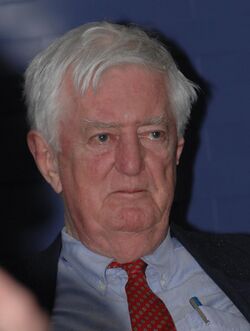Biography:Oliver Selfridge
Oliver Selfridge | |
|---|---|
 Selfridge in 2008 | |
| Born | Oliver Gordon Selfridge May 10, 1926 London, England |
| Died | December 3, 2008 (aged 82) Belmont, Massachusetts, U.S.[1] |
| Alma mater | Massachusetts Institute of Technology (BS) |
| Known for | Pandemonium Architecture |
| Scientific career | |
| Fields | Mathematics, Computer science, Artificial Intelligence |
| Institutions |
|
Oliver Gordon Selfridge (10 May 1926 – 3 December 2008) was a mathematician and computer scientist who pioneered the early foundations of modern artificial intelligence.[2] He is mostly known for his 1959 paper, Pandemonium: A paradigm for learning describing what's now known as the Pandemonium Architecture. He has been called the "Father of Machine Perception."[3]
Biography
Selfridge, born in England, was a grandson of Harry Gordon Selfridge,[2] the founder of Selfridges department stores. His father was Harry Gordon Selfridge Jr. and his mother was a clerk at Selfridge's store. His parents had met, fallen in love, married and had children all in secret, and Oliver never met his grandfather, Harry Sr. He was educated at Malvern College, and, upon moving to the US, at Middlesex School in Concord, Massachusetts, before earning an S.B. from MIT in mathematics in 1945. He then became a graduate student of Norbert Wiener at MIT, but did not write up his doctoral research and never earned a Ph.D.
Marvin Minsky considered Selfridge to be one of his mentors,[4] and Selfridge was one of the 11 attendees, with Minsky, of the Dartmouth workshop that is considered the founding event of artificial intelligence as a field.
Selfridge wrote important early papers on neural networks, pattern recognition, and machine learning, and his "Pandemonium" paper (1959) is generally recognized as a classic in artificial intelligence. In it, Selfridge introduced the notion of "demons" that record events as they occur, recognize patterns in those events, and may trigger subsequent events according to patterns they recognize. Over time, this idea gave rise to aspect-oriented programming.
In 1968, in their formative paper "The Computer as a Communication Device", J. C. R. Licklider and Robert Taylor introduced a concept known as an OLIVER (On-Line Interactive Vicarious Expediter and Responder), which was named in honor of Selfridge.[5]
Selfridge spent his career at Lincoln Laboratory, MIT (where he was Associate Director of Project MAC), Bolt, Beranek and Newman, and GTE Laboratories where he became Chief Scientist. He served on the NSA Advisory Board for 20 years, chairing the Data Processing Panel. In 1991 he was elected a Fellow of the Association for the Advancement of Artificial Intelligence.[6] Selfridge retired in 1993.[7]
In 2015, Duncan Campbell identified Selfridge as his "best source" for Campbell's 1980 reporting on US National Security Agency wiretapping activity at RAF Menwith Hill in England.[8] Campbell described this operation in New Statesman as a "billion dollar phone tap".[9]
Selfridge also authored four children's books: Sticks, Fingers Come In Fives, All About Mud, and Trouble With Dragons.[10]
Selfridge was married and divorced twice and is survived by two daughters and two sons.[11]
See also
Notes
- ↑ https://www.nytimes.com/2008/12/04/us/04selfridge.html
- ↑ Jump up to: 2.0 2.1 Markoff, John (2008-12-03). "Oliver Selfridge, an Early Innovator in Artificial Intelligence, Dies at 82". The New York Times. https://www.nytimes.com/2008/12/04/us/04selfridge.html?partner=rss&emc=rss. Retrieved 2008-12-10.
- ↑ Spark, Andrew (2008-12-16). "Oliver Selfridge Computer scientist paving the way for artificial intelligence". The Guardian. https://www.theguardian.com/technology/2008/dec/17/oliver-selfridge-obituary. Retrieved 2012-08-04.
- ↑ "Personal page for Marvin Minsky". https://web.media.mit.edu/~minsky/people.html.
- ↑ Licklider, J.C.R (August 7, 1990). "In Memoriam: J. C. R. Licklider". https://web.stanford.edu/dept/SUL/library/extra4/sloan/mousesite/Secondary/Licklider.pdf.
- ↑ "Elected AAAI Fellows" (in en-US). https://aaai.org/about-aaai/aaai-awards/the-aaai-fellows-program/elected-aaai-fellows/.
- ↑ "Oliver Selfridge" (in en-GB). Daily Telegraph. 2008-12-22. ISSN 0307-1235. https://www.telegraph.co.uk/news/obituaries/3903053/Oliver-Selfridge.html.
- ↑ Duncan Campbell (3 August 2015), GCHQ and Me, My Life Unmasking British Eavesdroppers, The Intercept, https://firstlook.org/theintercept/2015/08/03/life-unmasking-british-eavesdroppers/
- ↑ America's big ear on Europe, New Statesman, 18 July 1980, pp. 10–14, http://www.duncancampbell.org/PDF/America%27s%20Big%20Ear%20on%20Europe%2018%20July%201980.pdf
- ↑ Markoff, John (2008-12-03). "Oliver Selfridge, an Early Innovator in Artificial Intelligence, Dies at 82" (in en-US). The New York Times. ISSN 0362-4331. https://www.nytimes.com/2008/12/04/us/04selfridge.html.
- ↑ "Oliver Selfridge" (in en-GB). Daily Telegraph. 2008-12-22. ISSN 0307-1235. https://www.telegraph.co.uk/news/obituaries/3903053/Oliver-Selfridge.html.
Further reading
- O. G. Selfridge. "Pandemonium: A paradigm for learning." In D. V. Blake and A. M. Uttley, editors, Proceedings of the Symposium on Mechanisation of Thought Processes, pages 511–529, London, 1959.
 |

